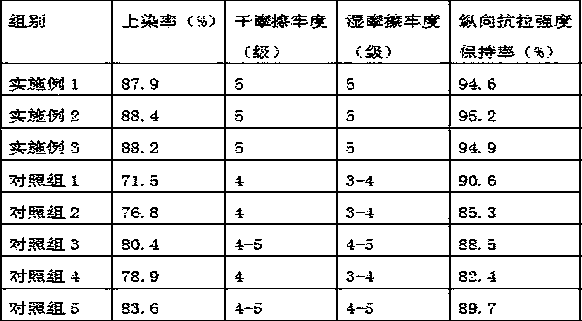Mat rush low-temperature dyeing method
A low-temperature dyeing and rush technology, applied in the field of rush low-temperature dyeing, can solve problems such as affecting the mechanical properties of rush, achieve the effect of improving the dyeing rate and rubbing fastness, and having a wide range of applications
- Summary
- Abstract
- Description
- Claims
- Application Information
AI Technical Summary
Problems solved by technology
Method used
Image
Examples
Embodiment 1
[0017] A low-temperature dyeing method for rush, comprising the following contents:
[0018] (1) After cleaning the collected rush grass, soak it in the pretreatment solution at a temperature of 40°C for 3.5 hours, drain the water after soaking, and conduct plasma treatment on it with a plasma device for 4 minutes, then dry it to Keep the moisture content below 10% for later use;
[0019] The pretreatment liquid includes the following raw materials in parts by weight: 1.2 parts of polyoxyethylene sorbitan monopalmitate, 3.2 parts of sodium fatty alcohol polyoxyethylene ether carboxylate, 3.8 parts of polyvinylpyrrolidone, triethanolamine stearate 7 parts of quaternary ammonium salt, 62 parts of alkaline pectinase solution whose mass concentration is 2.35%;
[0020] (2) Dye the above-treated rush and the composite dye solution at a volume bath ratio of 1:40, the dyeing temperature is 46°C, and the heat preservation treatment is 50 minutes;
[0021] The composite dye solution ...
Embodiment 2
[0029] A low-temperature dyeing method for rush, comprising the following contents:
[0030] (1) After cleaning the collected rush grass, soak it in the pretreatment solution at a temperature of 38°C for 4 hours, drain the water after soaking, and perform plasma treatment on it with a plasma device. After 3 minutes of treatment, dry it until Keep the moisture content below 10% for later use;
[0031] The pretreatment liquid includes the following raw materials in parts by weight: 1.6 parts of polyoxyethylene sorbitan monopalmitate, 2.2 parts of sodium fatty alcohol polyoxyethylene ether carboxylate, 5.3 parts of polyvinylpyrrolidone, triethanolamine stearate 6 parts of quaternary ammonium salt, 65 parts of alkaline pectinase solution whose mass concentration is 2.2%;
[0032] (2) Dye the above-treated rush and the composite dye solution at a volume bath ratio of 1:40, the dyeing temperature is 48°C, and the heat preservation treatment is 60 minutes;
[0033] The composite dy...
Embodiment 3
[0041] A low-temperature dyeing method for rush, comprising the following contents:
[0042] (1) After washing the collected rush grass, soak it in the pretreatment solution at a temperature of 42°C for 3 hours, drain the water after soaking, and conduct plasma treatment on it with a plasma device. After 5 minutes of treatment, dry it until Keep the moisture content below 10% for later use;
[0043] The pretreatment liquid includes the following raw materials in parts by weight: 0.8 parts of polyoxyethylene sorbitan monopalmitate, 4.2 parts of sodium fatty alcohol polyoxyethylene ether carboxylate, 2.4 parts of polyvinylpyrrolidone, triethanolamine stearate 8 parts of quaternary ammonium salt, 60 parts of alkaline pectinase solution whose mass concentration is 2.5%;
[0044] (2) Dye the above-treated rush and the composite dye solution at a volume bath ratio of 1:40, the dyeing temperature is 44°C, and the heat preservation treatment is 40 minutes;
[0045] The composite dye...
PUM
 Login to View More
Login to View More Abstract
Description
Claims
Application Information
 Login to View More
Login to View More - R&D
- Intellectual Property
- Life Sciences
- Materials
- Tech Scout
- Unparalleled Data Quality
- Higher Quality Content
- 60% Fewer Hallucinations
Browse by: Latest US Patents, China's latest patents, Technical Efficacy Thesaurus, Application Domain, Technology Topic, Popular Technical Reports.
© 2025 PatSnap. All rights reserved.Legal|Privacy policy|Modern Slavery Act Transparency Statement|Sitemap|About US| Contact US: help@patsnap.com

